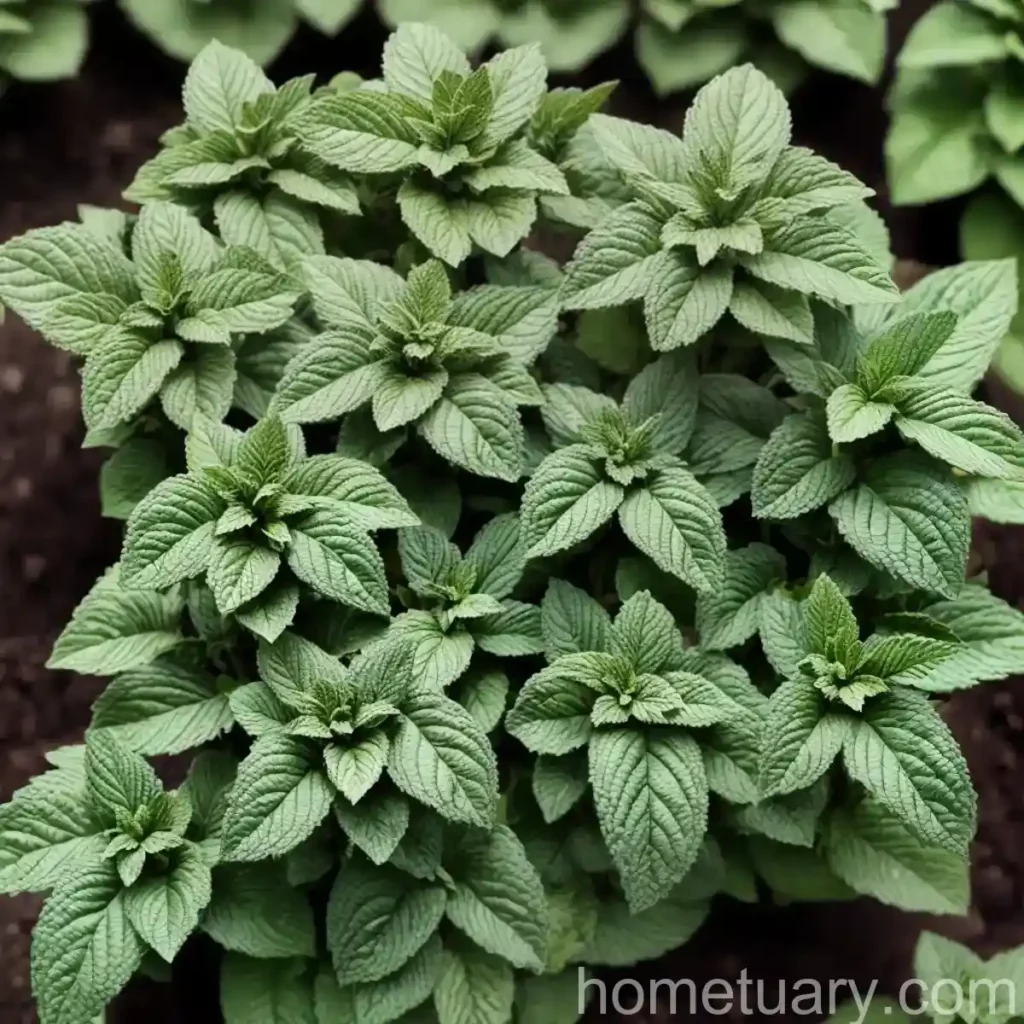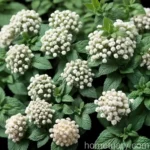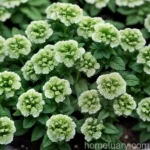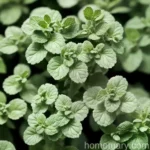Plant Scientist’s Guide to Chocolate Mint (Mentha x piperita f. citrata ‘Chocolate’)
As a plant scientist with a passion for herbs and botanical wonders, I am thrilled to share with you the fantastic world of chocolate mint, scientifically known as Mentha x piperita f. citrata ‘Chocolate’. In this comprehensive guide, we will delve into the culture, uses, maintenance, and interesting facts about this delightful plant. Whether you are a gardening enthusiast, a culinary artist, or simply someone who appreciates the beauty and utility of plants, there’s something for everyone in the captivating realm of chocolate mint.
What is Chocolate Mint (Mentha x piperita f. citrata ‘Chocolate’)?
Chocolate mint, a member of the Lamiaceae family, is a delightful cultivar of the peppermint plant, scientifically known as Mentha x piperita. This aromatic herb is highly esteemed for its luscious chocolate fragrance and flavor, making it a popular choice for both culinary and ornamental purposes. The unique scent and taste of chocolate mint add a delightful twist to various dishes, teas, and even homemade cosmetics, making it a versatile and enchanting addition to any garden or kitchen.
Now, let’s explore the fascinating world of chocolate mint, including its culture, uses, maintenance tips, and some intriguing facts that will deepen our appreciation for this remarkable plant.
Key Takeaways – Chocolate Mint (Mentha x piperita f. citrata ‘Chocolate’)
Before we delve into the details, here are the key takeaways that we will explore in depth throughout this guide:
- Chocolate mint, scientifically known as Mentha x piperita f. citrata ‘Chocolate’, is a delightful culinary herb with a rich chocolate fragrance and flavor.
- It can be used in various culinary creations such as teas, desserts, salads, and cocktails, adding a unique and refreshing twist to the dishes.
- Chocolate mint requires regular watering, partial sunlight, and fertile, well-drained soil to thrive.
- Proper pruning helps maintain the plant’s vigor and shape, and it can be propagated through stem cuttings or division.
- This aromatic herb is commonly grown in containers and is favored for its adaptable nature and delectable fragrance.
- Despite its resilience, chocolate mint is susceptible to certain pests and diseases, requiring proactive measures for protection.
- Botanist’s tips and fascinating facts about chocolate mint will enrich our understanding of this alluring plant and its myriad uses.
Now, let’s embark on a captivating journey through the enchanting world of chocolate mint, exploring its cultural significance, uses in various domains, and intricacies of care and maintenance.
Culture of Chocolate Mint
Understanding the cultural requirements of chocolate mint is pivotal for fostering its optimal growth and ensuring a bountiful harvest. Let’s explore the essential cultural considerations for cultivating this delightful herb.
Water
Proper watering is fundamental to the health and vitality of chocolate mint. This herb thrives in moist but well-drained soil and requires regular watering to maintain adequate moisture levels. However, it’s crucial to avoid waterlogging the soil, as excessive moisture can lead to root rot and other detrimental conditions. To meet its water needs, chocolate mint should be watered thoroughly whenever the soil surface feels dry to the touch. Additionally, it’s advisable to water the plant in the morning to allow excess moisture to evaporate during the day, reducing the risk of fungal diseases.
Sunlight
While chocolate mint appreciates ample sunlight, especially in cooler climates, it typically thrives in partial shade or dappled sunlight in warmer regions. When grown in full sun, chocolate mint may exhibit signs of stress, such as wilting or scorching of the leaves. Therefore, providing the plant with partial sun and some afternoon shade can help maintain its vigor and prevent sun damage. In indoor settings, chocolate mint can be positioned near a bright window where it can receive indirect sunlight, replicating its preferred light conditions in its natural habitat.
Soil
Chocolate mint flourishes in fertile, well-drained soil with a slightly acidic to neutral pH (6.0-7.0). Incorporating organic matter such as compost or well-rotted manure into the soil enhances its fertility and promotes the robust growth of chocolate mint. Furthermore, ensuring good drainage is vital to prevent waterlogged conditions that can compromise the plant’s health. For container cultivation, using a high-quality potting mix with excellent drainage properties is paramount for the overall well-being of chocolate mint.
Uses of Chocolate Mint
The delightful chocolate mint is prized for its multifaceted uses, spanning culinary, aromatic, and even therapeutic domains. Let’s take a closer look at the diverse applications of this enchanting herb.
Culinary Uses
One of the most cherished aspects of chocolate mint is its delectable fragrance and flavor, which infuse a delightful twist into a wide array of culinary creations. Its aromatic leaves can be used fresh or dried to impart a refreshing chocolate essence to teas, desserts, cocktails, salads, and savory dishes. Chocolate mint leaves can also be infused into syrups, sauces, and beverages, adding a delectable hint of chocolate to the culinary ensemble. In the realm of confectionery, chocolate mint is an exquisite addition to chocolate-based desserts, creating a harmonious and indulgent flavor profile that captivates the palate.
Aromatic Uses
The alluring fragrance of chocolate mint lends itself to various aromatic applications, enriching the ambiance of homes and gardens. The leaves and sprigs of chocolate mint can be utilized to create fragrant potpourri, sachets, and herbal wreaths, infusing indoor spaces with a delightful chocolate-scented allure. Additionally, the essential oil extracted from chocolate mint is valued in aromatherapy for its soothing and invigorating properties, contributing to relaxation and stress relief.
Medicinal Uses
In traditional herbal medicine, chocolate mint has been utilized for its potential therapeutic benefits. It is believed to contain essential oils and phytochemicals that may offer digestive support, alleviate mild discomforts, and promote overall wellness. Furthermore, the aromatic properties of chocolate mint make it a delightful ingredient in herbal teas and infusions that can help soothe the senses and provide a comforting experience.
Ornamental Uses
Beyond its aromatic and culinary prowess, chocolate mint serves as a charming addition to gardens and landscapes, enhancing their visual appeal with its lush foliage and enchanting fragrance. Its vibrant green leaves with a subtle hint of purple and its delicate clusters of pale purple flowers add a touch of elegance to herb gardens, borders, and container plantings. When strategically positioned, chocolate mint can also serve as a natural deterrent for certain pests due to its invigorating fragrance, contributing to the ecological balance of the garden.
Maintenance of Chocolate Mint
Effective maintenance practices are essential for nurturing chocolate mint and ensuring its long-term vitality. From proper pruning to proactive pest management, let’s explore the key maintenance considerations for cultivating this exceptional herb.
Pruning
Regular pruning is instrumental in promoting the health, vigor, and aesthetic appeal of chocolate mint. By pruning the plant, especially after the flowering period, it encourages the growth of fresh foliage and prevents the plant from becoming leggy or unruly. To prune chocolate mint, simply trim the stems back to just above a leaf node, which stimulates new growth and helps maintain a compact and bushy habit. Additionally, promptly removing any yellowing or diseased leaves can prevent the spread of infections and contribute to the plant’s overall well-being.
Propagation
Chocolate mint can be propagated through several methods, including stem cuttings, division, or layering. Propagating chocolate mint through stem cuttings involves carefully selecting healthy stem segments, removing the lower leaves, and placing them in a moist growing medium to encourage root development. Division, on the other hand, entails separating the plant into smaller sections, each with its own roots and shoots, and replanting them in suitable locations. Layering is another propagation technique that involves encouraging the development of roots on a stem that is still attached to the parent plant, after which it can be severed and transplanted.
Container Cultivation
The adaptable nature and moderate size of chocolate mint make it a splendid choice for container cultivation. When grown in containers, it’s essential to select a spacious pot with adequate drainage holes to accommodate the plant’s roots and prevent waterlogging. Utilizing a high-quality potting mix enriched with compost and perlite or coarse sand can provide the ideal growing medium for chocolate mint. Additionally, regular watering and occasional fertilization are crucial for supporting its growth and ensuring its well-being.
Chocolate Mint’s Popularity
Chocolate mint’s alluring fragrance, versatile uses, and ease of cultivation contribute to its widespread popularity among gardeners, culinary enthusiasts, and herbalists. This aromatic herb has garnered a devoted following for its unique charm and remarkable applications, earning a esteemed place in gardens, kitchens, and the world of herbal remedies.
Common Diseases and Pest Management
While chocolate mint is generally resilient, it is susceptible to certain diseases and pests that can undermine its health and vigor. By understanding these potential threats and implementing proactive measures, we can safeguard chocolate mint from adverse conditions and contribute to its flourishing growth.
Common Diseases
Chocolate mint may be susceptible to fungal diseases such as powdery mildew and leaf spot, particularly in conditions of high humidity and poor air circulation. Powdery mildew manifests as a white powdery coating on the leaves and stems, while leaf spot appears as dark lesions on the foliage. To mitigate these diseases, providing ample air circulation, avoiding overhead watering, and promptly removing any infected plant material can help prevent their occurrence and minimize their impact.
Disease Diagnosis
When diagnosing potential diseases affecting chocolate mint, careful observation of the plant’s foliage, stems, and overall appearance is crucial. Symptoms such as discolored or distorted leaves, wilting, and unusual growth patterns can provide valuable cues about the plant’s health. Additionally, consulting with local agricultural extension offices or experienced horticulturists can offer insights into potential diseases prevalent in specific regions and effective management strategies.
Common Pests
Chocolate mint may be susceptible to certain pests, including aphids, spider mites, and whiteflies, which can feed on the plant’s sap and compromise its vigor. These pests can cause damage to the foliage, leading to stunted growth, wilting, and a decline in overall plant health. Implementing preventive measures, such as regularly inspecting the plant for signs of pests, promoting beneficial predators, and utilizing organic pest control methods, can help manage pest populations and protect chocolate mint from infestations.
Botanist’s Tips for Chocolate Mint
As we continue to explore the enchanting world of chocolate mint, here are some expert tips for cultivating and harnessing the full potential of this delightful herb:
Botanist’s tips
- Harvesting: To harvest chocolate mint, selectively clip the stem tips, allowing the plant to maintain its vitality and continuously produce fresh foliage. Harvesting before the flowering stage can help preserve the plant’s essential oils and maximize its aromatic qualities.
- Companion Planting: Chocolate mint thrives in the company of certain companion plants such as basil, parsley, and chives, with their symbiotic interactions promoting mutual well-being and deterring certain pests.
- Overwintering: In colder climates, chocolate mint can be overwintered indoors to protect it from frost and ensure its survival. Before moving the plant indoors, acclimatize it gradually to the indoor environment to minimize shock.
Fun Facts About Chocolate Mint
Discover some intriguing and delightful facts about chocolate mint that unveil its allure and diverse applications:
- The delightful chocolate fragrance of chocolate mint adds a captivating dimension to herbal teas, infusions, and bath products, creating a wonderfully indulgent sensory experience.
- Chocolate mint has been historically cherished for its unique aroma, with its leaves and flowers used to add a delicate chocolate essence to diverse culinary creations and herbal remedies.
Now that we have delved into the cultural significance, uses, maintenance, and fascinating facts about chocolate mint, you are well-equipped to embark on your journey of growing and savoring this remarkable herb. Whether it’s for delectable culinary creations, aromatic allure, or ornamental beauty, chocolate mint holds a special place in both gardens and hearts, offering a delightful sensory experience and a myriad of captivating possibilities.
Links to External Resources
For further information and insights on chocolate mint, explore the following external resources:
- National Garden Bureau – Chocolate Mint Profile
- RHS – Growing Chocolate Mint
- Missouri Botanical Garden – Mentha x piperita f. citrata ‘Chocolate’
- University of Florida IFAS Extension – Growing Herbs Mentha x piperita ‘Chocolate’
By delving into these additional resources, you can expand your knowledge and expertise on chocolate mint, enhancing your journey of cultivation, culinary exploration, and herbal appreciation.
With its enchanting fragrance, delightful flavor, and versatile nature, chocolate mint awaits to enrich your garden, enhance your culinary creations, and captivate your senses. Embark on this delightful botanical adventure and savor the nuanced allure of chocolate mint (Mentha x piperita f. citrata ‘Chocolate’), a truly exceptional herb that embodies the harmonious fusion of practical utility and sensory delight.















